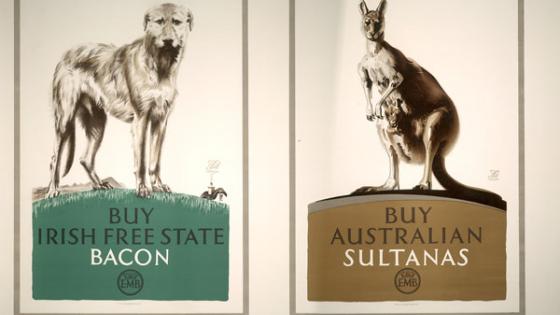In 2016, Britain took the bold decision to leave the EU, one of the world’s largest free trade blocs and Britain’s largest trading partner. Some believe that Brexit will herald a new era of trade expansion for Britain. Untethered from the EU, Britain can roam the world securing favourable trade deals with other trading partners, such as North America, the Far East and the Antipodes – or so it has been argued.
In contrast, almost a century ago, Britain ‘turned inward’ through the adoption in 1932 of a discriminatory trade policy that conferred various preferences to imports from the British Empire. According to a recent study by de Bromhead et al. (2019), tariffs and quotas were “the major reason why the share of UK imports coming from the British Empire increased during the 1930s”. They find that the preferential tariffs and quotas that Britain agreed at the Ottawa Conference of 1932 explain three-fifths of the increase in the Empire’s share of Britain’s imports from 27% in 1930 to 39% in 1935.
The Empire Marketing Board as soft trade policy
Unlike in the early 1930s, when the Empire’s share of Britain’s imports increased sharply (mostly due to policy), the Empire’s share of Britain’s imports was stagnant in the late 1920s. This fact is surprising since between 1926 and 1933, the British government sought to raise the share of its imports sourced from the Empire via the Empire Marketing Board (EMB).
The EMB was a distinctly non-tariff initiative intended to encourage the British consumption of Empire goods through, inter alia, publicity (Self 1994). Essentially, the EMB was a ‘soft trade policy’ vehicle for free-trade Britain to reciprocate the tariff preferences that its exports enjoyed in Empire markets.
To date, much of the literature on the EMB has claimed that it served an important function by fostering imperial ideology within the empire (see, especially, Constantine 1986a, 1986b, Barnes 2014). Those who have considered the economic impact of the EMB have done so in general terms. Survey evidence appears to offer some support that the EMB was effective, but this evidence related to ‘better-off’ consumers who frequented Waitrose (Thackeray 2017).
There seems to be a consensus that for the majority of the population, relative prices determined whether consumers purchased Empire goods. According to Constantine (1986a), “[a] sizeable proportion of the population could not afford to have their patterns of consumption affected by ideological considerations … it may be that in this respect tariff preferences, which affected prices, were a more effective method of imperial economic engineering”.
Reappraising the economic impact of the EMB
Our study (Higgins and Varian 2019) provides the first econometric assessment of the effectiveness of the EMB. Relying on a sample of the iconic posters produced by the EMB and widely displayed throughout British cities in 1927 (the EMB’s first full year of operation), we test whether those posters that made reference to a specific colony and commodity raised the share of the advertised colony in Britain’s imports of the advertised commodity.
A battery of time series regressions for butter (New Zealand), cheese (New Zealand), grain (Canada), sugar (Mauritius), rice (India), tea (Ceylon), frozen beef (Australia), and butter (Irish Free State) yields no consistent evidence that the EMB achieved its aim of diverting Britain’s imports toward the Empire.
From one perspective, our results suggest that appeals to patriotic imperial ‘self-help’ were fundamentally misguided. Empire suppliers had to compete with well-established foreign suppliers whose products were held in high esteem by British consumers.
For example, chilled Argentine beef was a far superior product to the frozen product from Australia. Indeed, by the late 1920s, the retail trade in frozen beef had almost disappeared; the bulk of imports were destined for public institutions and the armed forces!
Similarly, New Zealand butter was in competition with Danish ‘Lur Brand’ butter, which predominated in much of northern England (Barnes and Higgins 2019). The potency of foreign competition was certainly underestimated by the EMB.
Possibly the greatest obstacle confronting the EMB was conflict between its poster campaigns and the failure of retailers to differentiate produce from individual dominions and those of the Empire as a whole.
The principal explanation for this practice was that following the Merchandise Marks Act of 1926, grocers were not required to indicate the origin of their produce unless, as a result of this statute, a Marking Order was in force. But such Orders permitted either the use of the country of origin or the term “Empire”; the decision on which type of marking to use was at the discretion of the retailer (for a discussion of this Act, see Higgins 2018).
Consequently, butter from New Zealand and the Irish Free State could legitimately be sold as “Empire”. Conversely, attempts to differentiate Indian and Ceylon tea from foreign tea under the 1926 Act were rejected because much of this tea was blended with tea from Java, Sumatra or China, and sold under company brands, such as Lipton’s Red Label, with which consumers associated more closely.1
Finally, we argue that the publicity expenditure of the EMB was small relative to the value of Empire imports. From 1928 to 1931, the publicity expenditure of the EMB averaged £0.68 per £1,000 of Empire imports. Contemporaneous marketing campaigns run by various commodity-specific control boards were better funded.
For example, the publicity expenditure of the New Zealand Dairy Produce Control Board, which marketed New Zealand butter and cheese to British consumers, was £1.33 per £1,000 of Britain’s bilateral imports of butter and cheese from New Zealand. The discrepancy is even wider than the two publicity expenditure figures suggest, since a substantial portion of the EMB’s publicity expenditure advertised British goods to the domestic market – Britain itself was a part of the Empire.
Conclusions
The EMB was a novel official initiative to foster trade between Britain (the ‘mother country’) and the British Empire. It sought to complement the cultural and political ties that existed within the Empire by publicising the economic benefits that arose when intra-Empire trade increased. But the EMB failed in achieving its objective of increasing the Empire’s share of Britain’s imports by means of soft trade policy. There are several explanations.
First, even allowing for the fact that publicity was only part of the EMB’s total expenditure, the sums devoted to these activities were small in relative terms, especially compared with the expenditure of the produce control boards. It is surprising, therefore, that in discussions leading to the abolition of the EMB in 1933, the Secretary of State for the Colonies stated that he did not believe that the publicity campaigns launched by the Dominions would “ever succeed in building up a goodwill similar to that built up by the Marketing branch of the Board”.2
Second, appeals to imperial sentiment conflicted with economic reality; during the late 19th century Britain emerged as the biggest global importer of produce, and this dominance continued into the interwar period. Consequently, the activities of the EMB were constrained by entrenched consumer preferences for Danish butter, chilled Argentine beef, and other non-Empire foodstuffs.
Finally, the EMB’s efforts to promote colony-specific produce conflicted with statutory provisions designed to safeguard consumers from misrepresentation. The Merchandise Marks Act of 1926 permitted retailers to sell Australian beef and New Zealand butter as ‘Empire’ produce.
References
Barnes, F (2014), “Bringing Another Empire Alive? The Empire Marketing Board and the Construction of Dominion Identity”, Journal of Imperial and Commonwealth History 42(1): 61-85.
Barnes, F, and D M Higgins (2019), “Brand Image, Cultural Association and Marketing: ‘New Zealand’ Butter and Lamb Exports to Britain during the Interwar Period”, forthcoming in Business History.
de Bromhead, A, A Fernihough, M Lampe and KH O’Rourke (2019), “When Britain Turned Inward: The Impact of Interwar British Protection”, American Economic Review 109(2): 325-52, Vox column.
Constantine, S (1986a), “Bringing the Empire Alive”, in J M MacKenzie (ed.), Imperialism and Popular Culture, Manchester University Press.
Constantine, S (1986b), Buy and Build: The Advertising Posters of the Empire Marketing Board, London.
Higgins, DM (2018) Brands, Geographical Origin and the Global Economy, Cambridge University Press.
Self, R (1994), "Treasury Control and the Empire Marketing Board", Twentieth Century British History 5(2): 153-82.
Thackeray, D (2017), “Buying for Britain, China or India? Patriotic Trade, Ethnicity and Market in the 1930s Empire/Commonwealth”, Journal of Global History 12: 386-409.
Varian, B, and D M Higgins (2019), “Money Talks – Give Yours an Empire Accent: The Economic Failure of Britain’s Empire Marketing Board, 1926-33”, paper presented at the Economic History Society’s 2019 annual conference.
Endnotes
[1] Board of Trade, Merchandise Marks Act, 1926: Report of the Standing Committee respecting Tea, London, 1929
[2] The National Archives (TNA), CO 323/1248/19, Economic Consultations and Cooperation, Committee of Imperial Economic Cooperation, 17 October 1933.


